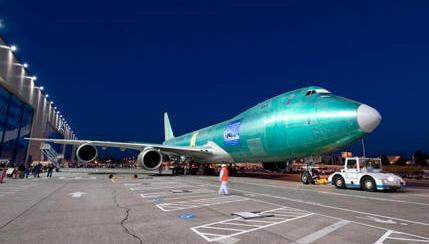
NEWSROOM
 |
NEWSROOM |
|
|
|
||||
|
By Bill Goldston |
||||
|
|
||||
 |
November 13, 2009,
"It is very rewarding to see this airplane transition to the flight test
phase," said Mo Yahyavi, 747 program vice president and general manager.
"Our employees, suppliers and customers have put a lot of work into
making the 747-8 Freighter a reality." The 747-8 Freighter is the new high-capacity 747 that will give cargo operators the lowest operating costs and best economics of any freighter airplane while providing enhanced environmental performance. |
|||
|
It is 250 feet, 2
inches (76.3 m) long, which is 18 feet and 4 inches (5.6 m) longer than
the 747-400 Freighter. The stretch provides customers with 16 percent
more revenue cargo volume compared to its predecessor. That translates
to four additional main-deck pallets and three additional lower-hold
pallets.
Boeing has secured 105 orders for the 747-8, 78 of which are orders for
the new freighter. Cargolux, Nippon Cargo Airlines, AirBridgeCargo
Airlines, Atlas Air, Cathay Pacific, Dubai Aerospace Enterprise,
Emirates SkyCargo, Guggenheim and Korean Air all have placed orders for
the 747-8 Freighter.
On November 14, 2005, Boeing announced that it was launching the 747
Advanced as the "Boeing 747-8". This will be the first lengthened 747 to
go in to production. The 747-8 and 747SP are the only 747 variants with
a fuselage of modified length.
|
||||
|
Production of the first 747-8 Freighter began in
As of February 2009, only one airline customer (Lufthansa) has ordered
the 747-8I passenger model, and Boeing announced it was reassessing the
747-8 project. Chief executive Jim McNerney stated that continuation of
the project was not a foregone conclusion. The company was assessing
various options. Dec. 06, 2006, Deutsche Lufthansa AG announced the carrier ordered 20 747-8 Intercontinentals. The Lufthansa order, with a total average list-price value of $5.5 billion, is scheduled for delivery beginning in 2010.
The 747-8 Intercontinental is the only jetliner in the 400- to 500-seat
market, stretched 5.6 m (18.3 ft) from the 747-400 to provide 467 seats
in a three-class configuration and a 14,815-km (8,000-nmi) range. Using
787-technology engines, the airplane will be quieter, produce lower
emissions, and achieve better fuel economy than any competing jetliner.
The 747 Intercontinental will provide nearly equivalent trip costs and
13 percent lower seat-mile costs than the 747-400, plus 26 percent
greater cargo volume. Operating economics will offer a significant
improvement over the A380. The 747-8 is more than 10 percent lighter per
seat than the A380 and will consume 11 percent less fuel per passenger
than the 555-seat airplane. That translates into a trip-cost reduction
of 21 percent and a seat-mile cost reduction of more than 6 percent,
compared to the A380. Both the 747-8 Intercontinental and 747-8
Freighter can use the existing infrastructure and ground equipment at
most airports worldwide. The 747-8 Freighter will be longer than the 747-400F by 5.6 m (18.3 ft) and have a maximum structural payload capability of 140 metric tonnes (154 tons) with a range of 8,130 km (4,390 nmi). Also powered by 787-technology engines, it will achieve the same environmental benefits as the 747-8 Intercontinental. The 747-8 Freighter will have nearly equivalent trip costs and 16 percent lower ton-mile costs than the 747-400, plus 16 percent more revenue cargo volume than its predecessor. The additional 120 cu m (4,245 cu ft) of volume means the airplane can accommodate four additional main-deck pallets and three additional lower-hold pallets. Operating economics of the 747-8 Freighter will be significantly superior to the A380F. The 747-8F's empty weight is 80 tonnes (88 tons) lighter than the A380F, resulting in a 24 percent lower fuel burn per ton, 21 percent lower trip costs and 23 percent lower ton-mile costs than the A380F.
Seating: 467
passengers in a three-class configuration Range: Intercontinental 8,000 nmi (14,815 km) ? Freighter 4,390 nmi (8,130 km) |
| ?AvStop Online Magazine Contact Us Return To News |